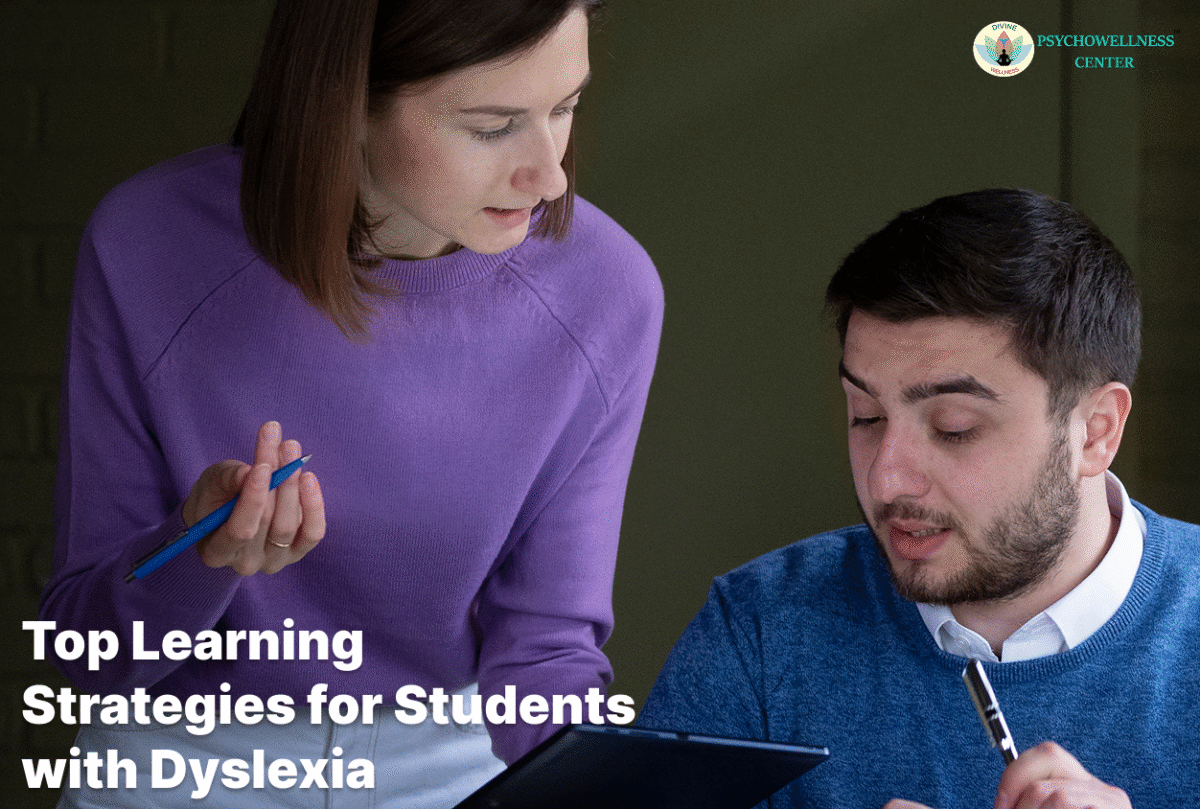Dyslexia is a neurological disorder that primarily affects reading, writing, and spelling abilities. It often becomes apparent during early education and continues through adolescence and adulthood. While dyslexia does not reflect a lack of intelligence or effort, it can lead to adjustment issues, low motivation, low self-confidence, and even social isolation, especially among adolescents trying to keep up with their peers.
Understanding and implementing the right learning strategies can make a significant difference in helping students with dyslexia succeed academically and emotionally. This blog outlines top learning strategies designed to support their cognitive development while also addressing common emotional and social challenges like developmental delays and the difficulty of connecting with peers.
1. Multi-Sensory Learning Techniques
Visual, aural, tactile, and kinesthetic senses are all used simultaneously in multisensory learning. For students with dyslexia, this approach reinforces memory and understanding by allowing them to process information through multiple channels.
Strategies include:
- Using letter tiles or sandpaper letters for tactile engagement.
- Listening to audiobooks and keeping up with the narrative.
- Drawing diagrams or using mind maps to visualise concepts.
This method not only supports literacy skills but also boosts self-confidence by allowing students to approach learning in ways that make sense to them.
2. Assistive Technology Tools
Technology offers incredible support for students with dyslexia, helping to bridge gaps in reading and writing.
Useful tools:
- Text-to-speech software: Allows students to hear written content, reducing frustration and increasing comprehension.
- Speech-to-text programs: Help students express themselves in writing without the barrier of spelling.
- Phonetic spell checkers: Assist in improving writing skills without constant teacher intervention.
Using assistive tech reduces dependence on others and promotes autonomy, which is essential for boosting motivation and confidence.
3. Structured Literacy Programs
Structured literacy focuses on teaching the structure of language explicitly and systematically. For students with dyslexia, programs such as Orton-Gillingham, Barton, or Wilson Reading are specifically created.
These programs help overcome developmental delays in reading and spelling by teaching:
- Phonemic awareness
- Phonics
- Morphology
- Syntax
- Semantics
Such targeted instruction addresses the core difficulties of dyslexia and helps students catch up with their peers academically.
4. Small Group or One-on-One Instruction
Students with dyslexia often benefit from individualised attention or small group settings, where lessons can be adapted to their specific learning pace and style.
Smaller learning environments can reduce anxiety, particularly for adolescents who may struggle with low self-confidence or social isolation in traditional classrooms. It also fosters trust and allows instructors to identify and address adjustment issues more effectively.
5.Social and Emotional Support
The emotional toll of dyslexia is often underestimated. Struggling with reading and writing in a typical classroom setting can lead to low motivation, feelings of inadequacy, and social isolation.
Support strategies include:
- Encouraging participation in group projects to foster interaction with peers.
- Offering praise for effort and progress, not just performance.
- Providing access to counselling or peer support groups.
Creating a supportive environment helps reduce adjustment issues and cultivates resilience and self-worth.
6.Consistent Routines and Clear Instructions
For dyslexic students, routines that are well-defined and predictable can be reassuring. Instructions should be:
- Broken down into manageable steps
- Reinforced visually and verbally
- Accompanied by examples or demonstrations
This clarity improves classroom behaviour and academic achievement by reducing confusion and assisting students in focusing.
7. Parental and Teacher Collaboration
Close collaboration between parents, teachers, and specialists ensures consistency in support strategies both at school and at home. It allows for:
- Early identification of learning difficulties
- Monitoring progress
- Adjusting teaching methods as needed
Strong communication among adults in a student’s life also builds a network of encouragement and accountability that can mitigate low motivation and self-esteem issues.
8.Encouraging Strengths and Interests
Every student has strengths. For those with dyslexia, highlighting and nurturing these talents—whether in art, music, sports, or problem-solving—can counterbalance academic struggles.
Encouraging these interests:
- Builds self-confidence
- Fosters a growth mindset
- Reduces the emotional impact of academic setbacks
By feeling successful in other areas, students are more likely to persevere in challenging academic subjects.
Conclusion
Dyslexia poses unique challenges, but with the right support, students can thrive both academically and socially. Tailoring learning strategies to suit their individual needs—while addressing emotional and social hurdles like low motivation, adjustment issues, and social isolation—is key.
When peers, educators, and families work together to provide understanding and support, students with this neurological disorder can develop into confident, motivated, and successful learners.
For additional guidance, Psychowellness Center, located in Dwarka Sector-17 and Janakpuri, New Delhi (Contact: 011-47039812 / 7827208707), offers specialised Child Counselling, Cognitive Behavioural Therapy (CBT), Parental Guidance, and Family Therapy to support children with learning differences such as dyslexia. Their team of child psychologists and therapists provides a nurturing, evidence-based environment where both children and parents can build resilience, improve communication, and foster emotional well-being. For those seeking flexible access to mental health care, TalktoAngel, a trusted online therapy platform, connects individuals and families with the best psychologists and counsellors across India. Through these combined supports, families can feel empowered to understand and advocate for their child’s unique learning needs, ensuring no child with dyslexia walks the path alone.
Contribution: Dr. R.K. Suri, Clinical Psychologist, and Ms. Drishti Rajore, Counselling Psychologist
References
- Psychowellness Center. (2025, October 13). Top learning strategies for students with dyslexia. Psychowellness Center. https://www.psychowellnesscenter.com/top-learning-strategies-for-students-with-dyslexia
- TalktoAngel. (2025, October 13). Supporting students with dyslexia through emotional and cognitive therapy. TalktoAngel. https://www.talktoangel.com/supporting-students-with-dyslexia
- Orton-Gillingham, A., & Wilson, B. (2025, October 13). Structured literacy programs for students with dyslexia. Dyslexia Education. https://www.dyslexiaeducation.org/structured-literacy-programs

